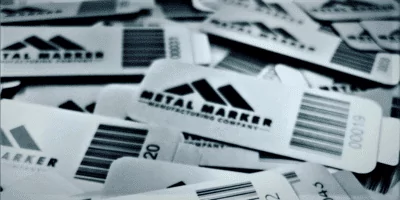Companies use special labels with unique codes and descriptions to create an assets tag for equipment tracking. This is especially helpful if that equipment is being regularly used or moved to different locations within or outside of its main office. These tools are part of larger industrial labeling solutions that companies employ for the sake of costs and safety.
What Are Asset Tags for Equipment?
Metal asset tags for equipment are specialized labels used to track, manage, and identify tools, machinery, and other valuable assets in various industries. These tags help companies monitor their equipment, reduce loss or theft, and streamline maintenance schedules.
By incorporating barcode scanning, RFID technology, or GPS tracking, asset tags ensure efficient asset management, improving productivity and operational control.
Asset Tags by Industry
Different industries have unique needs when it comes to asset tracking. Metal asset tags for equipment must be tailored to specific environments to ensure durability and readability.
They can be used in various sectors, which include the following:
- Manufacturing and Industrial Sectors: In factories and production facilities, metal asset tags for equipment are widely used to help track machinery, tools, and inventory efficiently.
- Healthcare Industry: Hospitals and clinics rely on asset tracking tags to manage medical devices, ensuring they are properly sanitized and available when needed. Equipment asset tags with barcodes allow staff to scan and update asset records.
- Construction Industry: Asset tags for equipment provide real-time tracking and reduce losses due to misplacement or theft.
- Education and IT Departments: Schools and businesses use asset tags to track laptops and other equipment to manage their inventory.
Durability
Several factors, such as durability and design, are important when selecting equipment asset tags. Here are a few options at your disposal:
- Metal Equipment Asset Tags: Anodized aluminum tags are among the most durable options, capable of resisting abrasion, moisture, and UV exposure.
- Polyester and Vinyl Tags: These offer a more flexible option for indoor equipment, providing resistance to mild chemicals and scratches.
- RFID and Barcode Tags: Depending on the material used, these tags can be embedded into hard plastic or laminated for protection.
Applications and Uses
Asset tracking tags serve multiple purposes across industries, helping organizations maintain order and efficiency. Here are some of the ways you can use them in your organization:
- Inventory Management: Tags streamline inventory processes by allowing quick scanning and updating of equipment records.
- Loss Prevention and Security: Metal tags discourage theft by marking company assets with serial numbers and company details, making unauthorized transfers difficult.
- Maintenance Scheduling: Regular servicing of machinery and equipment is essential. Metal tags for equipment help record maintenance history, ensuring timely inspections and preventing unexpected failures.
- Compliance and Audits: Many industries require strict compliance with safety and operational regulations. Properly labeled assets simplify audits and ensure compliance with industry standards.
4 Benefits of Having an Assets Tag for Equipment
#1 Better Inventory Control
With an assets tag, companies can better trace inventory levels and take preventive measures to ensure a popular product is regularly stocked before it gets critically low. Being this proactive prevents businesses from slowing or even stopping their sales momentum in a way they would have to without industrial labeling solutions in place.
#2 Ongoing Maintenance and Compliance
One of the most common issues in inventory management is human error. Assets tags streamline the process by simplifying record keeping. With the proper information, companies have a better idea of asset health and life expectancy, giving them ample opportunity to schedule repairs or buy a replacement.
#3 Reduce Theft and Loss Costs
These trackable labels help businesses keep a digital eye on where their equipment is or has been. This type of register means equipment that’s critical to a business’s bottom line has an audit trail that can be evidence for insurance claims.
#4 Simplify Cost Tracking
From the crib to the project site or from the warehouse to the shipping line, tagging business assets saves time and money. If an asset has reached the point where it’s a depreciation, it can be properly adjusted in the company’s ledger.

3 Categories of Assets That Need to be Tagged
There are three general categories of assets that need labels. They are:
#1 Movable Assets
Movable assets that can be shared across locations need to be tracked for the sake of accountability when it comes to damage or equipment losses. Some examples include heavy machinery used on construction sites or various types of office equipment that may reside at a single location but are handled by many people.
#2 Fixed Assets
Fixed assets may not be mobile but need to be serviced regularly to avoid unexpected and hazardous future breakdowns that can seriously impact business function. Manufacturing machinery such as turbines or power units are a couple of examples of equipment that’s necessary for daily operations.
#3 High-Value Assets
High-value assets may be expensive or may have sensitive company data. While they could belong to either of the previous categories as well, these are the types of high-value equipment that would be a struggle to replace if anything happened to them.
4 Types of Asset Tracking Tags Available
When looking for industrial labeling solutions, there are several different options available for the types of tags for your assets. They are:
#1 Barcodes
Barcodes are the most abundant and basic type of asset label that almost everyone in the world has encountered. While there are several types of 1D barcode labels, there are two widely used types: Code 39 and Code 128. Code 39, also known as the 3 of 9 Barcode, allows uppercase alphabet and numbers, along with a few special characters. Code 128 uses the ASCII character set, making it capable of more characters than Code 39 and more precise.
#2 QR Codes
QR codes are more advanced than barcodes. These are black modules in the shape of a square that can include any information. It’s really easy to create custom asset tags with QR codes that are scannable by cameras on smart devices.
#3 RFID Tags
RFID tags use radio waves to transmit the necessary information. Companies that use this require a special type of equipment that’s pricey but demonstrates that they aren’t afraid of more advanced technology. The beauty about RFID tags is that they don’t have to be visible to be scannable, making them a good option for tracking high-value assets.
#4 GPS Assets Tag
GPS tags are the most expensive and difficult to set up but they are also advanced. They provide real-time records of times and locations. This is one of the ways companies keep track of vehicles that transport cargo or passengers.
Material for Your Custom Asset Labels

When choosing the right asset tags for equipment, there are a few options. Polyester asset labels work well on curved or uneven surfaces. They have a permanent adhesive on the back and can contain any information, including the company logo, name and other material information.
Out of all the possibilities, a metal assets tag is the best type of label available. Not only are they weather-resistant, but they stand up against the type of abrasion that can damage tags and make them unscannable.
There are several types of anodized aluminum tags, including foil asset labels and rigid aluminum asset tags, which are mostly used on manufacturing or industrial equipment. Metal tags stand up to harsh environments, chemicals, and solvents that can eat away at the vital information they hold.
Whether you’re looking to secure office equipment or heavy-duty equipment, Metal Marker Manufacturing can customize your metal tags and decals for your business, no matter the quantity. Contact us to see how we can get the job done.